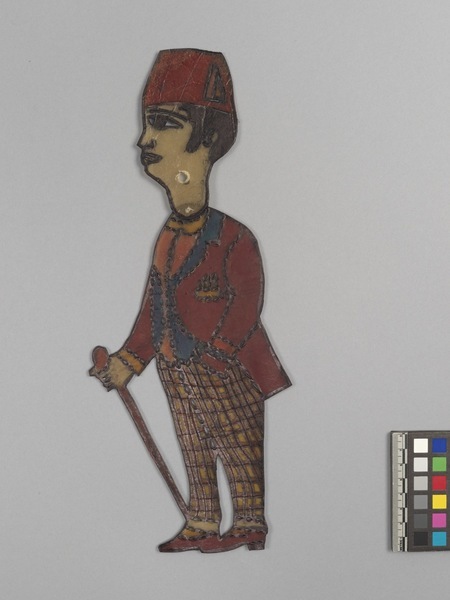Shadow Puppet Item Number: 3364/8 from the MOA: University of British Columbia

Description
Shadow puppet of the character Celebi, made of semi-transparent animal skin and a watery paint or dye, soaked into the skin. The puppet head and body are separate pieces, tied together with a thin plastic cord through small holes at the neck. Figure is a male, wearing checked pants, a long red suit jacket, red hat and shoes. He holds a walking stick in one hand, his other hand is in his pocket; he has black hair and a mustache. The hole for the stick (to manipulate the puppet) is in his upper neck. The maker's name is written along the back of the neck.
History Of Use
Shadow puppet character, from the Turkish shadow play known as "Karagöz & Hacivat". The play dates back to the Ottoman Empire (c. 1299-1923). It follows the escapades and fights of the two central characters from whom it takes its name. These friends are opposites in many ways: Karagöz (Black Eye) is illiterate and coarse, but well-intentioned, and very funny. Whereas Hacivat is pretentious and conceited, well-spoken and amusing. The plays are full of wit and satire and social and ethnic stereotypes as well as supernatural characters, such as monsters and magicians. Karagöz shadow puppetry was inscribed on UNESCO’s List of the Intangible Cultural Heritage of Humanity in 2009.
Iconographic Meaning
The character called Çelebi represents a young gentleman in European style dress.
Item History
- Made by Ercan Aksakal (Maker) in Bursa, Turkey during 2019
- Owned by Consulate General of the Republic of Turkey before May 17, 2019
- Received from Consulate General of the Republic of Turkey (Donor) on May 17, 2019
What
- Name
- Shadow Puppet
- Identification Number
- 3364/8
- Type of Item
- puppet
- Material
- animal skin, paint and plastic
- Overall
- height 33.5 cm, width 13.5 cm, depth 0.5 cm
Who
- Culture
- Turkish
- Creator
- Ercan Aksakal (Maker)
- Previous Owner
- Consulate General of the Republic of Turkey
- Received from
- Consulate General of the Republic of Turkey (Donor)
Where
- Holding Institution
- MOA: University of British Columbia
- Made in
- Bursa, Turkey
When
- Creation Date
- during 2019
- Ownership Date
- before May 17, 2019
- Acquisition Date
- on May 17, 2019
Other
- Condition
- excellent
- Accession Number
- 3364/0008